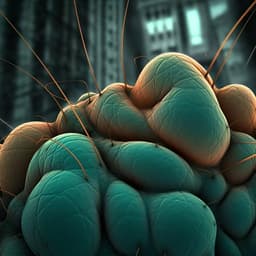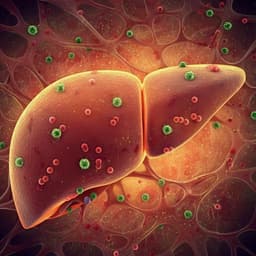
Environmental Studies and Forestry
Mesophilic and thermophilic viruses are associated with nutrient cycling during hyperthermophilic composting
H. Liao, C. Liu, et al.
This groundbreaking research by Hanpeng Liao, Chen Liu, Chaofan Ai, Tian Gao, Qiu-E Yang, Zhen Yu, Shaoming Gao, Shungui Zhou, and Ville-Petri Friman reveals how DNA viruses play a crucial role in nutrient cycling during hyperthermophilic composting. Through advanced metagenomics and metatranscriptomics, the study uncovers the intricate relationship between viruses and their bacterial hosts, highlighting the importance of viral abundance in ecosystem functioning.
Playback language: English
Introduction
Decomposition of organic matter is crucial for nutrient cycling and ecosystem productivity. While bacteria and fungi play major roles, the influence of bacteriophages (phages) remains poorly understood. Phages, the most abundant biological entities, drive microbial mortality through cell lysis, impacting element cycling and microbial community composition. While their importance in ocean nutrient cycling is well-established, their role in soil ecosystems is less clear. Some studies have shown that virus-encoded auxiliary metabolic genes (AMGs) contribute to carbon cycling in soil by encoding enzymes like glycoside hydrolases. However, our understanding of the combined effects of viruses and bacteria on nutrient cycling in terrestrial ecosystems is limited.
This study uses hyperthermophilic composting (HTC) as a model system to examine the roles of mesophilic and thermophilic bacteria and their viruses in organic matter decomposition. HTC is a waste treatment technology achieving high temperatures (up to 90 °C) through thermophilic bacterial activity. It involves three phases: hyperthermophilic (>80 °C), thermophilic (>50 °C), and maturation (ambient temperature). During these phases, various organic substances are degraded. The microbial communities driving degradation change dynamically with temperature, with thermophilic bacteria being important in the thermophilic phase. While temperature and physicochemical properties have been studied extensively, the viral role in HTC is largely unknown.
Viruses could impact HTC in two ways: first, through top-down control of bacterial abundances via lysis, shaping nutrient cycling and ecological succession; and second, by providing functional genes (AMGs) that enhance decomposition. Viral activity, assessed via metatranscriptomics, indicates successful infection. This study aimed to investigate bacterial and viral community composition, diversity, and activity in relation to carbon and nitrogen turnover during HTC, comparing the roles of mesophilic and thermophilic bacteria and their DNA viruses in nutrient cycling dynamics.
Literature Review
The existing literature highlights the significant role of microbial communities (bacteria and fungi) in the decomposition of organic matter and subsequent nutrient cycling in terrestrial ecosystems. However, there's a considerable gap in our understanding of the role of viruses, specifically bacteriophages, in these processes. Although bacteriophages are the most abundant biological entities, their impact on nutrient turnover and microbial community structure in soil environments remains poorly investigated compared to their well-established roles in aquatic systems. Several studies have started to unveil the potential contribution of virus-encoded auxiliary metabolic genes (AMGs) in processes like carbon cycling, demonstrating the presence of genes associated with carbohydrate degradation and methane metabolism. However, a comprehensive understanding of the interplay between bacterial and viral communities in driving nutrient cycling in soil and other terrestrial ecosystems is still lacking. The limited research available suggests a complex interplay where viruses can influence bacterial populations through lysis and also possibly aid in nutrient acquisition and degradation of toxic compounds by their hosts. This study aims to address this knowledge gap by employing a unique model system (hyperthermophilic composting) to explore the intricate relationship between bacterial and viral communities and nutrient cycling under extreme conditions.
Methodology
This study employed a full-scale hyperthermophilic composting (HTC) experiment conducted in a plant located in Shunyi district, Beijing, China. Sewage sludge and rice husk were used as composting materials. Samples were collected at eight time points (days 0, 4, 7, 9, 15, 21, 27, 33, and 45) covering all phases of the HTC process (initial, hyperthermophilic, thermophilic, and maturation). Physicochemical properties (temperature, organic matter (OM), total carbon (TC), water-soluble carbon (WSC), total organic carbon (TOC), inorganic carbon (IC), total nitrogen (TN), water-soluble nitrogen (WSN), ammonium (NH4+), nitrate (NO3-), pH, water content (WC), electrical conductivity (EC)) were measured.
Bacterial community composition and diversity were analyzed using 16S rRNA gene amplicon sequencing (Illumina NovaSeq6000 platform). DNA and RNA shotgun sequencing were performed on three replicate samples at four time points (days 0, 4, 15, and 27), yielding 12 metatranscriptome and 12 metagenome samples. Metagenome-assembled genomes (MAGs) were reconstructed using SPAdes, MetaBAT2, MaxBin2, and Concoct. Viral contigs were identified using DeepVirFinder, VirSorter2, CheckV, and VIBRANT. Viral operational taxonomic units (vOTUs) were clustered using CD-HIT. Virus-host linkages were predicted using three in silico methods (shared genomic content, CRISPR spacer linkages, and tRNA matching). Auxiliary metabolic genes (AMGs) were identified using DRAM-v and manual curation. Metatranscriptomic analyses were performed to determine active bacterial and viral taxa and gene expression.
RNA viruses were analyzed using RNA-dependent RNA polymerase (RdRp) as a target gene. Statistical analyses included ANOVA, PERMANOVA, Mantel tests, Random Forest, and PLS-PM to assess correlations between microbial communities, activity, and nutrient cycling. The optimal growth temperature (OGT) of MAGs was predicted using Tome v1.1. Thermophilic MAGs were defined as OGT ≥ 50 °C, while mesophilic MAGs had OGT < 50 °C.
Key Findings
The study revealed a strong coupling between bacterial and viral community dynamics during the different phases of HTC. The temperature increase was closely followed by changes in organic matter decomposition, carbon and nitrogen turnover. Total carbon and nitrogen contents decreased significantly by the end of the composting process, while water-soluble carbon and nitrogen increased, peaking during the hyperthermophilic phase.
16S rRNA gene sequencing and metagenomic analysis identified diverse bacterial communities, dominated by Firmicutes, Acidobacteriota, Bacteroidota, Deinococcota, and Proteobacteria. Bacterial community composition and richness were significantly affected by composting temperature, indicating a deterministic assembly process.
Metagenomic analysis identified 1297 viral operational taxonomic units (vOTUs), primarily double-stranded DNA viruses, mostly lytic. Viral community richness and composition also followed different phases of HTC, mirroring the bacterial community changes. A significant positive correlation was observed between bacterial and viral community richness and composition.
The study reconstructed 227 high-quality bacterial MAGs (180 mesophilic, 47 thermophilic) and identified virus-host linkages for 21.3% of vOTUs, with several viruses infecting thermophilic bacteria. Bacterial and viral abundances and community compositions showed a strong positive correlation. In contrast, active MAGs and vOTUs correlated negatively, suggesting a dynamic interplay and potential kill-the-winner dynamics.
Metatranscriptomic analysis revealed that bacterial activity closely followed the composting phases, with mesophiles dominant in the initial phase and thermophiles active during the hyperthermophilic phase. Viral activity also followed composting temperature, with mesophilic viruses more active at the beginning and thermophilic viruses during later phases. Bacterial and viral activities were significantly associated with nutrient cycling.
Analysis of catabolic genes revealed that bacteria expressed genes related to carbohydrate metabolism, lipid metabolism, amino acid metabolism, and nitrogen metabolism. Mesophilic bacteria expressed nitrogen metabolism genes, while thermophiles expressed carbohydrate metabolism genes (CAZymes). Mesophilic viruses encoded and expressed AMGs linked to carbon cycling (CAZymes), contributing to carbohydrate degradation. No AMGs were associated with nitrogen metabolism in viruses.
Analysis of virus-host abundance ratios (VHRs) showed a clear increase during the thermophilic phase. VHRs were positively correlated with composting temperature, WSC, WSN, and OM degradation rate, indicating a role of viruses in boosting nutrient cycling through top-down regulation.
Multiple regression models revealed that viral community activity contributed significantly more than bacterial activity to nutrient turnover, particularly carbon cycling. PLS-PM analysis showed that both mesophilic and thermophilic bacteria were positively associated with carbon and nitrogen cycling. Only mesophilic viruses were strongly associated with carbon cycling, while thermophilic viruses showed no significant association with nutrient turnover. RNA viruses were found to be predominantly associated with eukaryotes and did not significantly correlate with nutrient cycling.
Discussion
This study provides strong evidence for the crucial role of viruses in terrestrial biogeochemical cycles and nutrient turnover, particularly in extreme thermophilic environments. The observed tight coupling between bacterial and viral community dynamics, mirroring the phases of HTC and organic matter decomposition, highlights the intricate interplay between these communities. The dominance of mesophilic viruses during early stages and thermophilic viruses later reflects a succession driven by temperature and potentially by the kill-the-winner dynamic. The finding of viral AMGs, specifically CAZymes in mesophilic viruses, directly links viruses to carbon cycling, further supporting their active role in nutrient turnover. The lack of nitrogen-associated AMGs in viruses warrants further investigation. The positive correlation between virus-host ratios and nutrient turnover suggests that viral abundance could serve as a useful proxy for assessing ecosystem functioning in such environments.
While the study primarily focused on DNA viruses due to their prevalence and documented roles in nutrient cycling, the limited analysis of RNA viruses suggests they are not major players in HTC. This, however, doesn't rule out their potential roles in other systems or under different conditions. The predominantly lytic nature of the identified viruses suggests a substantial contribution to the 'viral shunt' mechanism in this system, where viral lysis releases nutrients that support microbial growth, thereby influencing nutrient cycles.
Conclusion
This study demonstrates a significant role for viruses in nutrient cycling during hyperthermophilic composting, particularly through the top-down control of bacterial populations and the expression of carbon-cycling AMGs by mesophilic viruses. The tight coupling between viral and bacterial communities, the significant correlation between VHR and nutrient cycling, and the identification of novel viral diversity underscore the importance of incorporating viral ecology into our understanding of terrestrial biogeochemical cycles. Future research should focus on validating the functional roles of identified AMGs and exploring the potential of viral abundance as an indicator of ecosystem function for optimizing biotechnological and agricultural systems.
Limitations
The study's reliance on in silico predictions for virus-host linkages and AMG identification is a limitation. While these methods have proven useful, experimental validation would strengthen the conclusions. The relatively low quality of many viral genomes also limited the functional analysis. Although the study sampled multiple time points, the temporal resolution might not fully capture rapid shifts in viral-bacterial interactions. The focus on DNA viruses potentially underestimates the role of RNA viruses, especially given the harsh temperature conditions. Future studies should address these limitations using more advanced techniques and focusing on improving viral genome quality.
Related Publications
Explore these studies to deepen your understanding of the subject.







